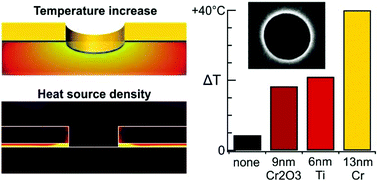Our official English website, www.x-mol.net, welcomes your
feedback! (Note: you will need to create a separate account there.)
Adhesion layer influence on controlling the local temperature in plasmonic gold nanoholes.
Nanoscale ( IF 5.8 ) Pub Date : 2020-01-13 , DOI: 10.1039/c9nr08113e Quanbo Jiang 1 , Benoît Rogez 1 , Jean-Benoît Claude 1 , Antonin Moreau 1 , Julien Lumeau 1 , Guillaume Baffou 1 , Jérôme Wenger 1
Nanoscale ( IF 5.8 ) Pub Date : 2020-01-13 , DOI: 10.1039/c9nr08113e Quanbo Jiang 1 , Benoît Rogez 1 , Jean-Benoît Claude 1 , Antonin Moreau 1 , Julien Lumeau 1 , Guillaume Baffou 1 , Jérôme Wenger 1
Affiliation

|
Gold films do not adhere well on glass substrates, so plasmonics experiments typically use a thin adhesion layer of titanium or chromium to ensure a proper adhesion between the gold film and the glass substrate. While the absorption of light into gold structures is largely used to generate heat and control the temperature at the nanoscale, the influence of the adhesion layer on this process is largely overlooked. Here, we quantify the role of the adhesion layer in determining the local temperature increase around a single nanohole illuminated by a focused infrared laser. Despite their nanometer thickness, adhesion layers can absorb a greater fraction of the incoming infrared light than the 100 nm thick gold layer leading to a significant increase of the local temperature. Different experimental designs are explored, offering new ways to promote or avoid the temperature increase inside nanoapertures. This knowledge further expands the plasmonic toolbox for temperature-controlled experiments including single molecule sensing, nanopore translocation, polymerization, or nano-optical trapping.
中文翻译:

粘附层影响等离子体金纳米孔中局部温度的控制。
金膜不能很好地粘附在玻璃基板上,因此等离子技术实验通常使用钛或铬的薄粘附层,以确保金膜和玻璃基板之间具有适当的粘附力。尽管将光吸收到金结构中主要用于产生热量并控制纳米级的温度,但在很大程度上忽略了粘合层对该过程的影响。在这里,我们量化粘附层在确定由聚焦红外激光照射的单个纳米孔周围的局部温度升高中的作用。尽管其厚度为纳米级,但与100纳米厚的金层相比,粘合层可以吸收更多的入射红外光,从而导致局部温度显着升高。探索了不同的实验设计,提供了促进或避免纳米孔内部温度升高的新方法。该知识进一步扩展了等离子体控制工具箱的温度控制实验范围,包括单分子传感,纳米孔易位,聚合或纳米光学捕获。
更新日期:2020-01-13
中文翻译:

粘附层影响等离子体金纳米孔中局部温度的控制。
金膜不能很好地粘附在玻璃基板上,因此等离子技术实验通常使用钛或铬的薄粘附层,以确保金膜和玻璃基板之间具有适当的粘附力。尽管将光吸收到金结构中主要用于产生热量并控制纳米级的温度,但在很大程度上忽略了粘合层对该过程的影响。在这里,我们量化粘附层在确定由聚焦红外激光照射的单个纳米孔周围的局部温度升高中的作用。尽管其厚度为纳米级,但与100纳米厚的金层相比,粘合层可以吸收更多的入射红外光,从而导致局部温度显着升高。探索了不同的实验设计,提供了促进或避免纳米孔内部温度升高的新方法。该知识进一步扩展了等离子体控制工具箱的温度控制实验范围,包括单分子传感,纳米孔易位,聚合或纳米光学捕获。










































 京公网安备 11010802027423号
京公网安备 11010802027423号